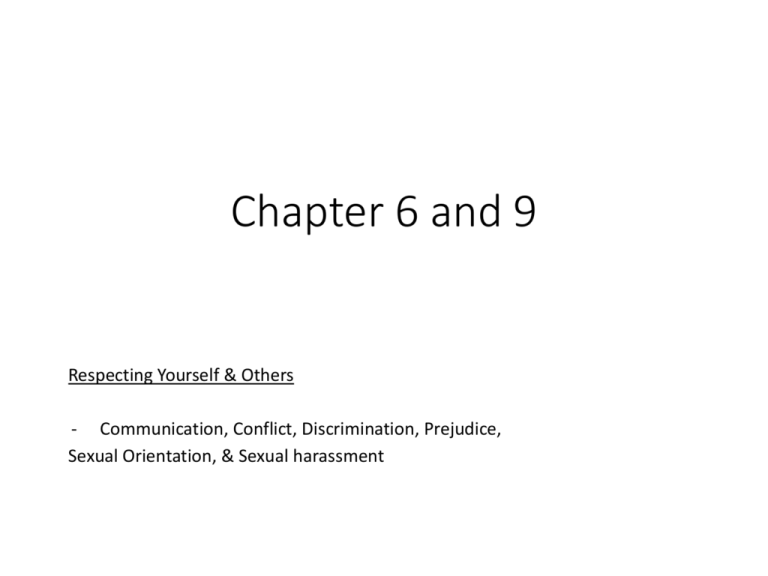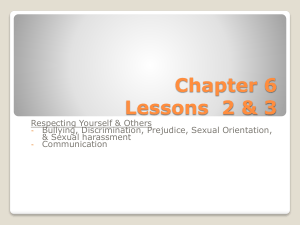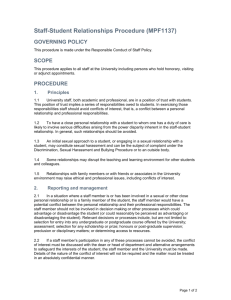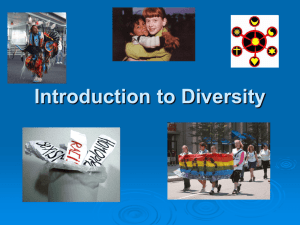Chapter 6 and 8 Respect Yourself and Others
advertisement

Chapter 6 and 9 Respecting Yourself & Others - Communication, Conflict, Discrimination, Prejudice, Sexual Orientation, & Sexual harassment Do Now • Write directions from Cherokee South parking lot to your house Directions Map Communication- ways of sending and receiving messages 1) Verbal- speaking 2) Non-verbal- body language, gestures, facial expressions, behaviors, and posture Communicating Styles 1) Passive- unable express thoughts 2) Aggressive- try to get way through intimidation 3) Assertive – express views clearly and respectfully To Communicate effectively you need to learn speaking skills, listening skills, and nonverbal communication. SPEAKING SKILLS Types of Messages You messages – blaming or shaming “You never let me do anything” I messages – healthful “I wish you could trust me enough to allow me to do things” I MESSAGE I feel ____________________________(be specific) when you _________________________________ (give details of the behavior or circumstances) Because _________________________________ (this is the hard one: the "why") Mixed Messages – verbal & non-verbal do not match Listening Skills Active Listening – pay close attention to what someone is saying and communicating TECHNIQUES • Don’t Interrupt • Show interest (eye contact, body language, remove distractions) Empathize Ask Questions Active Listening Activity Man on the left: 1. Hands are clasped and locked. He is defensive 2. Crossed legs. He is defensive. 3. Facial expression. He is not smiling and doesn’t look convinced. He is directly looking at the woman on the right who is his main concern. 4. Body orientation. His whole body is directly facing the woman on the right. He is confrontational with the woman Woman in the middle: 5. Gesturing. Heavy gesturing is used to justify a particular position. 6. Legs apart. Legs are not crossed and instead are apart. This suggests a threatening posture. 7. Direct eye contact with the woman on the right. Another confirmation of direct focus and an attack. Woman on the right: 8. Pointing to self. A classic defensive gesture justifying a position. 9. Legs are tightly closed. Suggests a defensive stance. 10. Direct eye contact. She is directly looking at the person who is attacking her to maintain focus. Chapter 9 Lessons 1,2,3, Resolving Conflict & Preventing Violence - Conflict - Date Rape Activator… THINK, PAIR, SHARE 1. Open your notes to page 2… THINK of how you can eliminate verbal and non verbal communication barriers. 2. PAIR up with someone in your surrounding area. 3. SHARE your ideas with your partner. Ask each other the question, How can working on our communication help us avoid conflict? Daily Objective: You will be able to identify common causes of conflict, explain the importance of preventing conflict, and describe the resolution process. In your journal, do now… 1. What is conflict? 2. When I think of the word conflict, I think of... 3. What types of conflicts have you experienced in your life? 4. How can social media impact a conflict you are having? 5. Pretend that you are having a conflict with a friend of yours. What are some different ways the conflict can be resolved? 6. Do the words “conflict” and “violence” mean the same thing to you? Explain. Conflict is a normal part of life, everyone is different so it is inevitable we will disagree sometimes. Conflict- any disagreement, struggle, or fight Interpersonal conflict-disagreement between two or more people Internal conflict- struggle within yourself 6 Common Causes of Conflict Power struggles –conflict with parent over how late you are allowed to stay out Loyalty –angry at a best friend for taking another person’s side in an argument Jealousy/Envy –upset with a friend if they start dating someone they like Property Disputes – angry for sibling borrowing phone without permission Conflicting attitudes/values – one person might want to hang with the “cool crowd” while the other wants to be friendly with everyone Lack of respect – rude to classmate for no reason, prejudice Escalating Conflict becoming more serious What cause conflict to escalate? Is the result of conflict always negative? Resolving Conflict Learning to manage and deal with conflict before it gets out of hand can help strengthen all aspects of health. It is easier to prevent conflict than to resolve it!!! Compromise – give and take Negotiation – use of communication and compromise to settle disagreements - Calm Down - Explain Side (take turns) - Understand each others position –ask for clarification if needed - Brainstorm solutions - Discuss the advantages - Agree on a solution – does not always mean everyone agrees - Follow up to see if the solution still works Preparing for Negotiation: Choose the time and place carefully, check your facts, plan what you will say… Stay calm is the most important thing! Mediation – neutral third party helping negotiation, if needed... can be specially trained people. Peer mediation – process in which specially trained students help other students resolve conflicts peacefully Neutrality – must always be an outsider who has no stake in the dispute Confidentiality – respecting the privacy of both parties and keeping the details secret Well-defined ground rules – both parties must agree to the rules made by the mediator… sometimes may have to sign something Group Activity Directions: Brainstorm ideas to create your specific situation within your assigned common cause of conflict. Assign roles to each group member. (narrator, actors/actresses…). You can use your paper when presenting your skit to the class!!! Begin creating your skit!!! Format Names: Topic: Jealousy Specific situation: feeling excluded from friends Intro roles: Narrator = name Sally = name Johnny = name Ted = name Narrator: plot, describe setting, set the tone Begin lines for skit, use narrator as needed Present conflict Don’t forget the resolution!!! THE END Class 1 Group Assignments Power Struggles 3 Harsh, Mia, Katelyn M, Ray Property Disputes 2 Alex, Chris, Caity, Taylor Loyalty 6 Kira, Damien, Kyle, Liz, Brendan Conflicting Attitudes 1 Brandon, Aiden, Blake, Kaiden Jealousy/Envy 4 Michaela, Sufi, Dylan, Sanjana Lack of respect 5 Peter, Alexia, Jake, Sofie, Marissa Sexual Harassment ANY unwelcome verbal or physical advances or suggestions of a sexual nature. Non-touch In groups come up with examples Touching Examples Sexual Harassment Sexual gestures Drawling or pictures sexual obscene Touches you & unwelcomed Comment sexual orientation Constantly invite you out Flirting vs. Sexual Harassment • Wanted • Confident Feeling • Complimentary • Mutual or shared • Non threatening • Builds self-esteem • Feels equal both parties • Can be flattering •Unwanted •Feels bad •Is degrading •Is one sided •Is threatening •Builds up ego giver •One person power •Demeaning and insulting Golden Rules cross out #5 and #6 •Courtesy over contact – (handshake not a hug) •Candid camera test – if a camera was on you would this action be appropriate •Personal space •Speak up – if you’re uncomfortable let the other person know •http://www.youtube.com/watch?v=euXzkLZ QPRY Discrimination & Prejudice Prejudice – unfair opinion or judgment of a particular group (Jackie Robinson ) (Ex: Racism) Discriminate – treating groups people differently (Ex: Title IX ) Hate crimes – crimes motivated by prejudice Extermination – physical attacks turn deadly Physical Attacks – expression of anger or resentment that has built from the first step (speech) Discrimination – Treating someone differently. Many different forms from denying a job to segregation Avoidance – avoiding the people that have been talked about and stereotyped Speech – talking or making fun of a group usually a result of stereotyping Stop Discrimination & Prejudice 1) No Stereotypes –exaggerated or oversimplified belief about group people - Interrupt behavior 2) Show Empathy- share in others emotions 3) Avoid comments that discriminate 4) Learn about different people In your journal, write your reaction… "Never doubt that a small group of thoughtful, committed citizens can change the world; indeed, it is the only thing that ever has." — Margaret Mead •Take out your Chapter 6 note sheets begin to answer the questions on the DO NOW side of the worksheet Do you think bullying is a serious problem in your school or community? Why or why not? What can YOU do to prevent or stop bullying? Bullying – harming or threatening other people who cannot defend themselves My kid wouldn’t bully Girls Boys 1 out of 4 students get bullied Types of Bullying: Physical, verbal, Cyberbullying, and hazing. Battle at Kruger FACTS Eighty-five percent of girls and seventy-five percent of boys surveyed say they have experienced unwanted and unwelcome sexual behavior that interferes with their lives. One-third of those students who have been harassed first experienced such unwelcome behavior before seventh grade. Studies indicate that there is a 75% chance that the harassment will continue or escalate if ignored. Sexual orientation – is recognition of a gender preference with regard to sexual attraction - homosexual – attracted to people of same gender - heterosexual – attracted to people opposite gender - bisexual – attracted to both genders ? ‘s to answer 1) How would it feel to hide something as basic as your sexual orientation?






